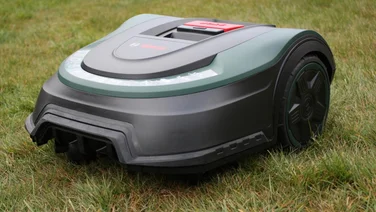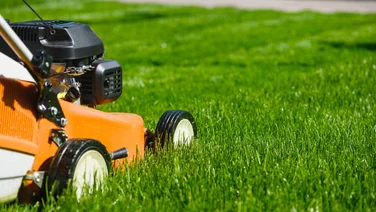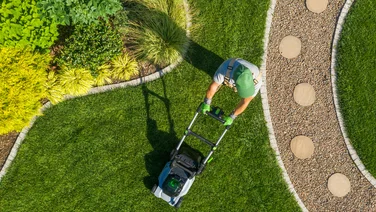To help us provide you with free impartial advice, we may earn a commission if you buy through links on our site. Learn more

If your garden is looking overgrown but the rain isn’t abating, you may find yourself wondering whether you can mow the lawn during wet weather. As the seasons change and the grass reaches lofty heights seemingly quickly, it can be tempting to abandon all reason and start mowing at full speed – whatever the weather. But when it comes to lawncare, timing is everything.
If it’s raining or the lawn is too wet when you mow, this can be detrimental to both your lawn and your lawnmower. Assessing the conditions of your grass and mowing at the right time can make all the difference to the end result. So if you’ve already bought yourself one of the best lawn mowers and you’re keen to get outside, here’s what the experts say about mowing your grass when wet. I’ve also included advice on when best to tackle your lawn mowing for optimum results.
Clumping can occur if the lawn is too wet
When the garden comes alive in spring and starts growing rapidly, it’s important to be gentle with the first few cuts of the season. On the first few mows of the year, only trim a top third of growth with the mower on the highest setting.
You should avoid mowing the lawn if there is frost on the ground or the soil is very wet as this can damage your lawn. “If you mow your grass when it’s wet, it’s harder to achieve a nice, clean cut,” says Rob Clarke, Technical Manager at garden company Westland Horticulture, which is home to brands such as Peckish, Unwins, Kent & Stowe, and Gro-Sure. “Wet grass will bend and clump together, so this will leave you with an uneven cut across your lawn.”
Mowing when wet is not great for your lawnmower or your grass
Not only can clumps of grass leave messy piles on your lawn, but these can also clog the lawnmower. The moisture can potentially bend or warp the blades resulting not only in an uneven cut, but permanent damage to your mower. The moisture can also have a negative impact on the motor of your mower and increase the risk of rust over time.

Aside from mowing, it’s not advisable to walk over a saturated lawn either. Applying pressure to a wet lawn can end up compacting the soil and cause issues with grass root growth. “Wet grass is much harder for a mower to cut, and the longer it gets the harder still,” says garden designer Matthew Wilson, who is a regular participant on Gardener’s Question Time on BBC Radio 4. “The weight of the water tends to flatten the grass. And if you’re cutting and collecting, wet grass tends to clog together and stop the grass making it through to the collection box.”
It can be unsafe to mow your lawn when it’s wet
I don’t mean to state the obvious, but water and electricity don’t mix, so mowing your lawn while it’s actually raining isn’t advisable. If you’re operating your mower in particularly wet conditions, there’s risk of electric shock. And even if you have a cordless mower, wet lawns can be slippery which means an increased chance of losing control of your mower and causing an injury. If you’ve got a sloped garden or uneven ground, this can increase the chances of your mower losing traction and make it harder to control in wet conditions. You could also use a petrol mower, but it’s still a risk.
How long should you wait to cut grass after rain?
How long you should wait to cut grass after it’s been raining all depends on how heavy the downpour is. For light rain, anything between six to 12 hours gives the grass and soil enough time to toughen up and dry. If it has been raining heavily overnight, it’s advisable to wait at least 24 hours before mowing the lawn.

“Depending on the weather, it may be a couple of days after rainfall before you can mow it,” says Rob Clarke. “To find out when your lawn is ready for mowing, it’s best to wait until it’s dry to touch and you’ll be able to see if the grass is dry as it’ll be standing upright. I’d say that late morning is the ideal time of day to mow your lawn as this gives enough time for any morning dew to evaporate, but before the heat of the day sets in. If you’re looking to create lines in your lawn when you mow, this is the best time to get that nice clean cut.”
Is there any way to cut wet grass safely?
It’s not advisable to mow your lawn when wet, and the experts agree that leaving it to grow a little longer rather than cutting it is best for your lawn and your lawn mower.
“While a little sunshine and, most importantly, some wind will soon dry grass out and make it ready for cutting, changeable weather can turn plans upside down,” says Matthew Wilson. “If the weather is unreliable, you can use a spring rake to knock the moisture off the blades of the grass. When it’s dry enough, you can set the mower to a high setting and take two or three passes to mow the lawn to its regular height. Before you know it, you’ll be outside with the sun shining and reaping the benefits of all your hard work.”






